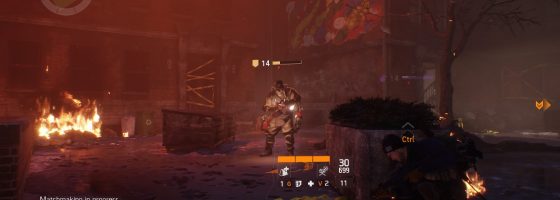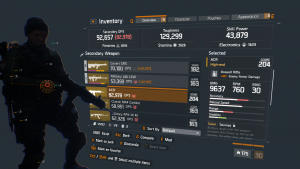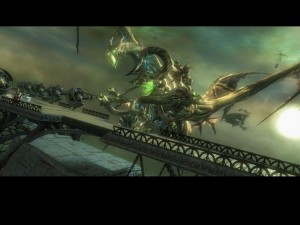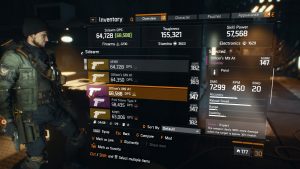The MMO genre has always been built on keeping people invested and playing. In the past, this has been in the form of expansions and more and more content. The problem is that there is only so much that can be added in this front, unless you have a dedicated team working round the clock.
For today’s post, I want to look at a new alternative to progression that recent MMO design has been using, and the pros and cons of it.
Gear Rating:
MMOs and RPG design by their nature are built on an ever growing scale of abstracted progression. A level 50 is always going to be better than a level 20 as an example. What recent MMO-based games have done is switch progression from a leveling system and instead put it on the gear.
“Gear Rating” or GR for this post, is an abstracted measurement of the player’s gear at the end-game. This becomes the new leveling or progression curve when the player is at the max level. Instead of having to raise the level cap via experience, now the player is hunting for items of higher GR.
The GR is an abstract stat that determines the stat range of an item and is defined by the designers. For instance: You could have two gloves, one has a GR of 110, and the other has a value of 150.
As the player collects items of a higher GR, their overall GR becomes a pseudo level for defining strength.
There are several major advantages of this kind of end-game model that we can talk about.
Getting Straight to the End:
MMOs traditionally have large leveling curves before the player hits the end game. However, the player will most often see and get access to all the mechanics long before they hit the level cap.
By focusing on a GR, it allows the designers to have a drastically shorten level cap. Both the Division and DC Universe Online have low leveling caps compared to MMOs like World of Warcraft. Once the player hits the cap, the focus is now on doing harder missions for gear of higher GR.
This allows the player base to all reach a point of stability or a baseline of the level cap that the designers can take into account when designing end-game content.
The low leveling cap also means that the developers can leave the early-game alone as players will blaze through it. Future support can focus on enhancing the end-game with new content that everyone can see.
Sustained Progression:
By taking the progression and switching it to gear, it allows designers to create an unending progression model. Because gear is abstracted, you can simply just continue to raise the max GR as you see fit instead of creating new levels.
As you continue to raise the GR up, it gives you the option to create new types of items that appear at specific GR. The Division as an example saves set pieces until you hit the level cap. If you play your cards right, you could give a foundation that allows for an infinite amount of progression for the players.
With that said, GR does have its downsides that you must plan for.
Artificial Progression:
GR is a great way for you to keep extending your progression curve, but a horrible way for the player to see progression. The point of leveling up is that the player’s character is growing in some way, and that’s the motivation to keep playing.
By focusing only on gear, the player no longer has a meaningful form of progression, but an artificial one. In the Division for example, I found a gun that was better for me stat-wise, but had a lower GR. Even though the weapon was better, I couldn’t use it if I wanted to keep my GR for missions.
GR as the only form of progression leads to peaks and valleys of progress for the player.
In DC Universe Online, you could only do end-game content if your GR was at certain milestones. Get unlucky with loot drops, and you won’t be able to move forward.
When focusing on GR, you must have an alternative to getting higher GR. Both DC Universe Online and the Division have vendors who sell comparable GR items. Depending on the game, vendor items could be better than those found or vice versa. The point is that if the randomization isn’t working, players must have a plan B.
All Dressed up With Nowhere to Go:
A GR-focused game does have the potential for infinite play with extending the GR. However, it also has the potential for infinite grinding on the player’s part. Without new content or things to challenge the player, they’re simply getting loot for the purpose of getting loot.
You cannot have a MMO-based title and expect your players to repeat the same content with no changes. The Division at this moment is suffering in the end-game department. The world tier system doesn’t add anything new to fight, but simply raises the stats of enemies.
Diablo 3 is still lacking as well in my opinion with the Torment system. Once you get to the Torments, there’s no motivation other than hoping to get more loot to challenge the player.
As designers, you cannot just sit back with a GR system and expect people to keep playing and paying. New content has to come regularly or people will get bored and stop playing.
In World of Warcraft’s case, the expansions are so big, that they can hold most players over until the next one. With any game built on long-term plans, once you set a schedule for new content, you must adhere to it.
The Future of MMOs?
World of Warcraft is still the undisputed king of the MMO market, but modern MMOs are trying new things to stand out. The likes of Destiny and DC Universe Online are still hanging in there, and we’ll have to see if the Division can bounce back following the 1.4 patch.
Thanks to focusing on GR, MMOs can say that there will always be something new for players to find, but will there be something to do? For everyone reading this, what are your thoughts on this change to progression?
If you enjoyed this post, please consider donating to the Game-Wisdom Patreon campaign. Your donations can help to keep the site going and allow me to produce more great content. Follow me on Twitter @GWBycer, and you can find daily video content on the Game-Wisdom YouTube channel.






